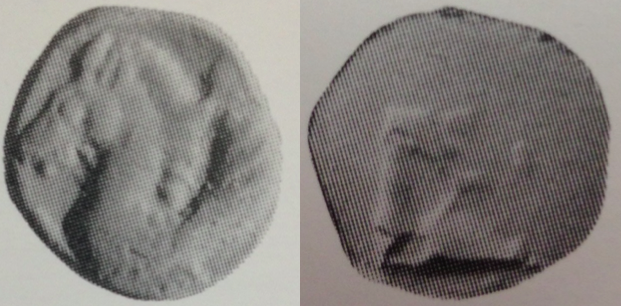Argilos, silver, 6th staters (520-478 BCE)
From SILVER
520 - 510 silver 2,510 kg
Description
| ObverseInscription or printing placed on the obverse.: | Protome of Pegasus left or right, galopping. |
| ReverseInscription or printing placed on the reverse.: | Incuse square divided in four triangles. |
Mint and issuing power
| MintIdentifies the place of manufacture or issue of a numismatic object.: | Argilos | Ancient regionAncient region.: | Macedon | Modern countryModern country: Greece | AuthorityIdentifies the issuing power. The authority can be "pretended" when the name or the portrait of X is on the coin but he/she was not the issuing power. It can also be "uncertain" when there is no mention of X on the coin but he/she was the issuing power according to the historical sources: |
Chronology
| FromIdentifies the initial date in a range assigned in a numismatic context. | 520 | toIdentifies the final date in a range assigned in a numismatic context.. | 510 | PeriodTime period of the numismatic object.: Archaic until 480 BC |
Physical description
| MetalThe physical material (usually metal) from which an object is made.: | silver"silver" is not in the list (Bronze, Silver, Gold, Lead, Aluminum, Iron, Copper, Steel, Brass, Zinc, ...) of allowed values for the "Metal" property. | Median weightMedian of the weights of numismatic objects (in grams). in grams | 2,6",6" can not be assigned to a declared number type with value 2. | DenominationTerm indicating the value of a numismatic object. Examples: tetradrachm, chalkous, denarius.: | hekte |
StandardStandard.: | |
| Average weightAverage of the weights of numismatic objects (in grams).: |
References
| Die study referencePublication of the study: | Liampi 20051Liampi 2005, p. 106-107, no. 3-4 and 6. | ||
| Coin series referenceReference to coin series study: | |||
Obverse dies distribution
| FrequencyFrequency of specimen in distribution. ᵖ | Number of obversesNumber of obverse dies. ᵖ (o) | % (o) | Number of coinsNumber of coins. (n) | % (n) | Die nameName(s) of the die(s). |
| 1 | 14 | 56 | 14 | 32.56 | 4, 6, 9, 10, 14, 16, 17, 18, 26, 38, 43, 56, 58, 60 |
| 2 | 6 | 24 | 12 | 27.91 | 40, 42, 55, 57, 59, 61 |
| 3 | 3 | 12 | 9 | 20.93 | 3, 11, 39 |
| 4 | 2 | 8 | 8 | 18.6 | 13, 41 |
| Total | 25 of 25 | 100 | 43 of 43 | 100 |
Reverse dies distribution
no distribution is available
Quantification
| Number of obversesNumber of obverse dies. ᵖ (o) | 3 | Number of singletons (o1)The number of singleton coins. ᵖ | 2 |
| Number of reverse diesNumber of reverse dies. (r) | 3 | Number of coinsNumber of coins. (n) | 5 |
| Coins per obverse dieNumber of coins per obverse die. (n/o) | 1.67 | Coins per reverse dieNumber of coins per reverse die. (n/r) | 1.67 |
| Reverse per obverse ratioRatio of obverse dies divided by reverse dies. (r/o) | 1 | Percentage of singletons (o1)number of coins (n) divided by the number of singletons (o1) ᵖ | 66.67 % |
| Original number of dies (O) (Carter 1983 formula)The estimation of the number of coins according to Carter 1983 ᵖ | 6.05 | Coins struck if 20,000 as average productivity per dieCoins made if the average productivity for obverses (according to Carter) is 20,000. ᵖ | 121,000 |
| Original number of dies (O) (Esty 2011 formula)The estimation of the number of coins according to the singleton formula in Esty 2011 ᵖ (O) | 7.5 | Survival rate if 20,000 as average productivity per dieSurvival rate if average productivity is 20,000. ᵖ | 0.00004 |
| Coverage (o = % of O) (Esty 1984 formula)Esty 1984 - coverage (% of O) ᵖ (o = % of O) | 60% | Die productivity if survival rate 1/2,000Average productivity if survival rate is 1/2,000. ᵖ | 1,652.89 |
| Weight of silver (in kg) if 20,000 coins per die (O = Carter formula)Carter 1983 * Median weight * 20000 (*10 if gold or electrum) ᵖ | 2,510 kg | Die productivity if survival rate 1/5,000Average productivity if survival rate is 1/5,000. ᵖ | 4,132.23 |
Remarks
Metrology p. 230-249.
References
- ^ Liampi, Katerini (2005), Argilos. A Historical and Numismatic Study, Athens
